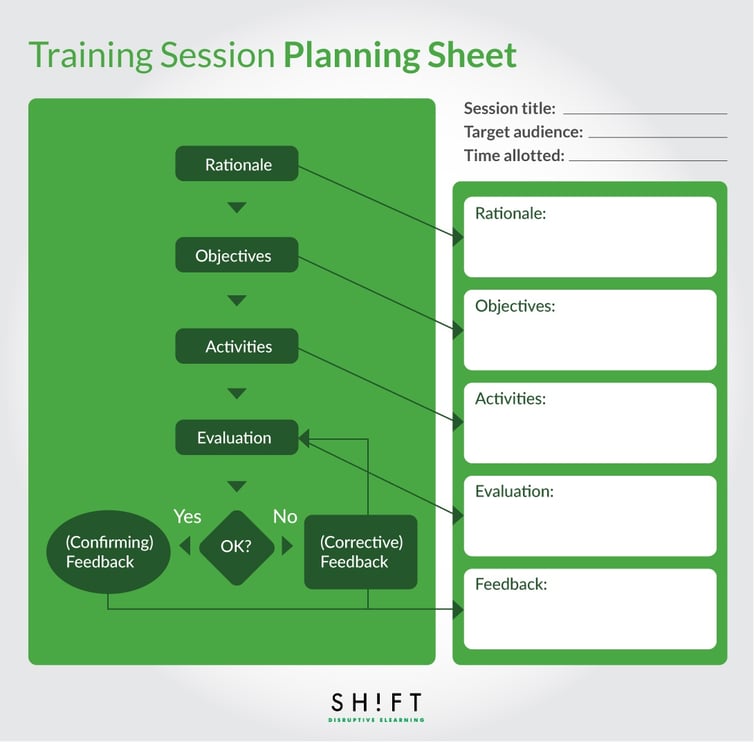Teachers create lesson plans in school. These are detailed documents containing what the teacher intends to teach during the session (the topics), how she plans to go about it (the methods and procedures), and how students would be evaluated at the end of the learning period (homework and assignments).
Every business has a well-defined plan to move forward too. It details the business goals and their deadlines, the strategies that have to be implemented to reach the desired numbers, and the methods to use to evaluate the efforts.
Plans help us organize our efforts, so we do not scatter our energies. Plans are structures that help us remain on track and not lose sight of our goals. And if you are an eLearning course developer, you need concrete roadmaps to ensure you are not veering away from the learning objectives or are wasting energy redoing tasks.
We have dug up a training plan template for you. It is comprehensive because it covers the fundamentals but also leaves enough wiggle room for you to give vent to your creativity. We loved it also because we could tweak the template and introduce other elements into the model without disrupting its flow. Hundreds of other organizations have also tested and tried this model, and it is a success!
Here’s the link to the original resource where the model is detailed out. Below is a ready reckoner to help you get started right away.

1) Provide the rationale for the course
Adult learners want to learn and are motivated to tweak their mindset and alter their behaviors IF they know what they are getting into and how the knowledge will help them become better versions of themselves. To put it bluntly, adult learners want to know, “What’s in it for me?” According to research, people learn better when they know why they are learning and how their knowledge and/or skill levels will improve after a training program.
Therefore, you need to identify the rationale behind the course to be developed before anything else. This will establish the relevance of the training program in the minds of the learners since the beginning.
Keep the following pointers in mind:
- Once you are clear of the "Why" of your course, make sure you provide it right at the start of the training program. You want to hook the learners before they are distracted and want to move away.
- Look for creative ways to explain the rationale. Provide the rationale using any medium—video, text, audio, or in person. Just make sure that the learners can really “see” themselves improved and empowered as a result of taking the training.
2) Define the learning objectives
When you specify the learning objectives, learners know exactly what they will be able to DO after they take the training. Think of objectives as a contract that you get into with learners. The learners want to know what you will deliver to them and how they will benefit from attending the training session.
Keep the following tips in mind before you frame the objectives:
- Frame the objectives, so they sound relevant to the learners.
- Make sure you use language that specifies the objectives clearly and leaves no ambiguity.
- Strong and well-written objectives describe outcomes, not activities or tasks. They focus on the terminal behavior and not the subject matter.
- A well-written objective should associate a single goal or outcome. For instance, it should avoid having a combination of two actions using ‘and’.
Read more: Are You Writing Rockin’ Course Objectives? 7 Do’s and Don’ts
3) Include activities and kill the boredom of passive learning
We all know passive learning is boring, and boredom disrupts the learning experience. The only way you can keep learners engaged is to incorporate activities in the training program.
Activities let learners discover knowledge and practice skills by doing. “Doing” is always more engaging than just listening to someone on the podium rattle off facts and definitions or reading through pages of text.
Here is the golden rule of creating activities in your training program: Create activities that align directly to the learning objectives.This establishes relevance and spurs engagement besides maintaining the focus of your training session.
Below are some more pointers to help you when you design activities for your training session:
- Design activities that not only engage learners but also provide opportunities for interaction. Think up events where learners get to exercise their imagination, use their critical reasoning faculties, share experiences, and build visions of the future.
- Make sure that you provide detailed and unambiguous instructions to the learners to help them perform the activities. Don’t let them waste mental energy trying to figure out how to proceed to the next level of a game or where to click next.
The following are some ideas for activities that you can include in your training program:
- Case Studies: Case studies demonstrate the relevance of what learners are being taught. By reading case studies, learners can join the dots and learn how they can apply the newly-acquired knowledge to solve practical problems. You can kill the passivity of case studies by introducing interaction, like rhetorical questions or quizzes (more on these later), in these.
- Rhetorical Questions: Rhetorical questions provoke learners to think laterally and consider unconventional perspectives. Such thought-provoking questions enable learners to discover the hidden aspects of a subject or a situation.
- Discussions and Debates: Discussions and debates are ideal activities to organize at the end of the training program. These activities let learners pose questions to the instructor and dispel their doubts or learn more about a topic.
- Quizzes: Quizzes or other question-based games enable learners to reflect on the learning once more.
- Demonstrations: Demonstrations are the ideal activities when you want to teach the steps of a process. You can organize a live demonstration or add a video demonstrating how to use a software. You can then ask learners to carry out the steps themselves; this will cement the learning in their minds.
- Hands-On Activities: Hands-on activities let learners carry out—in real time—the processes they learned during the training program. Of course, they are guided during the activity, but hands-on exercises are best for learning to apply theoretical knowledge in real life.
- Drills: Drills let learners perfect a task through repetition. Repetition enhances fluency and automates micro-tasks, so learners improve their efficiency.
Go through this excellent post that lists all the different kinds of learning activities you can include in your training program.
Here’s a little-known tip: Include a synthesizing activity to complement other activities that you might incorporate into the program.
A synthesizing activity gives learners the opportunity to collate different thoughts and the findings gleaned from other activities and create a body of knowledge they can apply at work. For instance, you can ask learners to create a list of best practices after they have performed several experiments or read a couple of case studies. Or you can ask them to create a troubleshooting guide or a safety checklist after they have watched a video demonstration.
4) Evaluate what the learners have learned
You obviously want to know if the training has been effective. You want to know if learners understand the concepts, can carry out the procedures and material they’ve learned. In other words, you want to find out if the learners have fulfilled the training goals they had set out to achieve.
Ensure that you assess learners on the degree to which they have been able to fulfill a specific training goal. For instance, a learning objective may be, “Identify the ingredients required to prepare a solution.”
Then you should make sure that learners can not only identify the elements but also state the exact quantity of each ingredient that will go into the solution.
- Create knowledge checkpoints and question-and-answer sessions and weave them in throughout the program (at the end of each module, or every certain number of slides).
- Use learning management systems (LMS) to automate the evaluation process for self-paced digital learning programs and record the results. Use these results to provide customized feedback or plan future training sessions.
- You can use a formal and rigidly-structured measurement approach, like Kirkpatrick’s Four-Level Training Evaluation Model.
5) Provide feedback.
Providing feedback is the next logical step after learners have taken an assessment. After all, they would want to know how well they have learned, and feedback motivates them to improve. And you too would want to rectify your learners’ mistakes and guide them on the learning journey.
Here are some tips to help you craft feedback that bolster the learning experience:
- Provide feedback that aligns with the learning objectives. Let learners know how close or far they are from fulfilling a particular objective.
- Provide feedback just after the learner has completed an assessment activity. This reduces stress in adult learners who might be anxious to know how they are performing.
- You can provide feedback just before a particularly challenging task. This feedback jogs the memory and helps learners mentally gather their thoughts and synthesize all that they have learned before they begin the activity.
- Ensure that you provide adequate feedback to help learners learn from their mistakes and perform better in the subsequent assessment activities. Include information like how learners can fulfill the learning objectives.
- Use an encouraging tone especially in the case of corrective feedback, so learners are not discouraged.
- Inform the learners that they have fulfilled a specific learning objective in the case of confirmatory feedback.
A structured training program eases the learning journey, both for the learners and the trainer. The five elements described above will help you design a training program, offline or online, that delivers meaning, substance, and relevance to learners.



